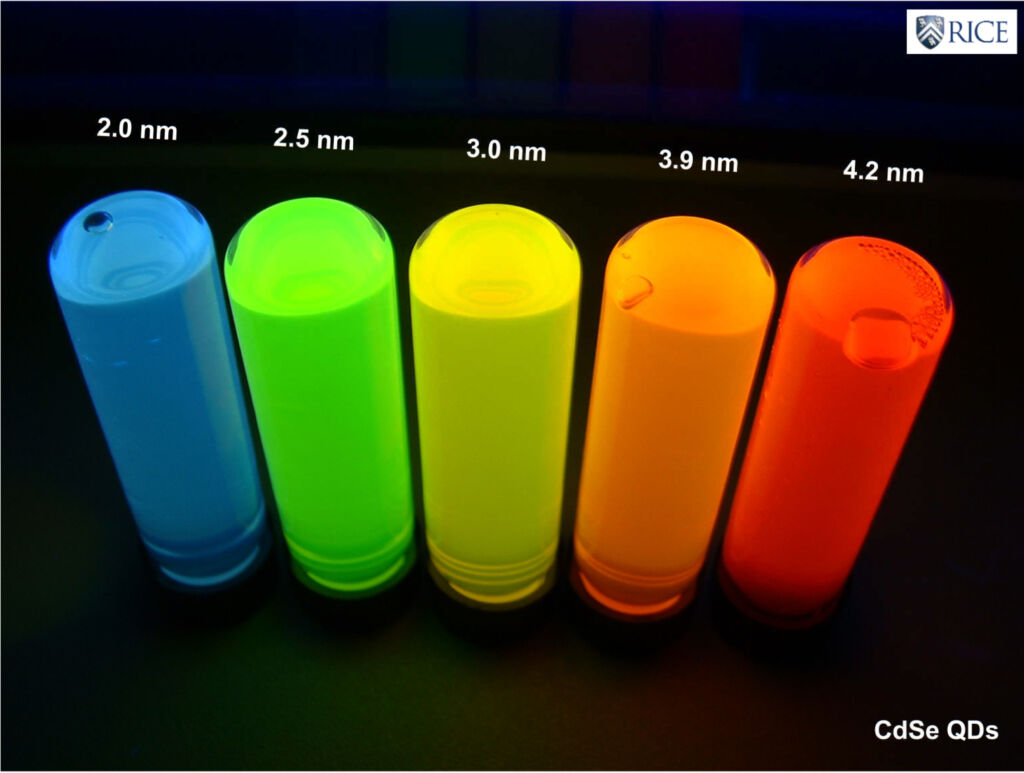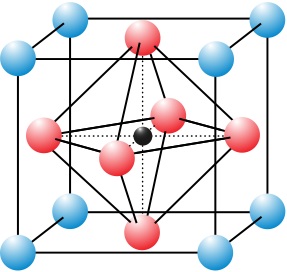Quantum dots, sometimes referred to as semiconductor nanocrystals, are an exciting emerging technology that we have covered previously on our blog. Quantum dots are artificial nanoparticles (on the order of 5-50nm in size) that are able to confine electrons to energy levels dependent on the shape and size of the quantum dot, allowing for tunable bandgap nanoscale semiconductors. Typically, quantum dots are composed of metal chalcogenides such as Indium Phosphate (InP) or Cadmium Selenide (CdSe). However, a new class of quantum dots utilizing the unique perovskite crystal structure has emerged, promising a unique host of benefits, and perhaps more than a few challenges. We will introduce a few key concepts of quantum dots, the benefits potentially conferred by perovskite nanocrystals, and the outlook of this novel technology as well as its potential applications.
Fundamentals of Quantum Dots

Solutions of cadmium selenide quantum dots of varying sizes, demonstrating the tunability of light emission energy, courtesy of Wikimedia commons.
Quantum dots act as “zero-dimensional” semiconductors, which provides them with a host of unique optical and electronic properties over their bulk counterparts due to unique quantum effects that occur at the atomic level. Since quantum dots are typically synthesized to be only tens of atoms in diameter, they are able to confine electrons to quantized energy states in much the same way atoms do (which has earned them the nickname “artificial atoms”).
Quantum dots composed of semiconducting material exhibit a bandgap, but with the twist that the bandgap is effectively controlled by the number of atoms composing the quantum dot – increasing the radius of a quantum dot lowers the effective band gap energy, which in the case of light emissive quantum dots, means a red-shifted color output. It is this unique property of bandgap tunability as a function of size that has provoked particular interest in quantum dots for LED technology. This popular use of quantum dots is bolstered by the fact that quantum dots tend to emit light in typically uniform Gaussian distributions, which would provide even further image clarity, in addition to their ability to emit light with greater energy efficiency than LCD or convention LED displays.
However, interest in quantum dots certainly does not stop at LED technology – quantum dots are also being researched for applications in photovoltaic solar cells, as well as CCD and CMOS photodetectors, both for quantum dots’ potentially much higher light conversion efficiency. Quantum dots have also found their way into biological applications, where they are being studied as a much brighter, more stable, and flexible fluorescent dye than traditional organic dyes used in cellular imaging and particle tracking. These advantageous properties could allow for significant advancement in screening cancerous cells, as well as in the delivery of anti-cancerous agents. Furthermore, even such fields as quantum computing could see significant advancements from quantum dot implementation. Quantum dots could serve as the medium in which qubits (quantum bits, a measure of information arising from states of quantum entanglement) are stored and transmitted.
What Are Perovskite Quantum Dots?

Generic Perovskite crystal structure, courtesy of Wikimedia commons.
Perovskite refers both to the inorganic compound calcium titanate, and more generally, to the crystal structure it forms. The perovskite crystal structure is composed generally of ABX3, where A and B are cations, and X is an anion. Perovskite-structured materials have received marked attention for their optoelectronic properties, especially with regards to photovoltaics, where they have shown promise for high-efficiency and low-cost solar cells. The immense amount of interest invested in Perovskites for solar cells since 2009 has dovetailed with further exploration into perovskite-based semiconductors. Since perovskite materials are relatively easy to manufacture, quantum dots composed of perovskite-structured compounds have shown promise in further reducing costs associated with quantum dot manufacture, bringing expansion of QLED technology to the mainstream further into the realm of reality.
Furthermore, perovskites have demonstrated bandgap tunability even beyond the inherent tunability associated with quantum dots, as the composition of anions and cations in a perovskite-based structure has been similarly noticed to change electrical bandgap properties of quantum dots. This increased tunability is also highly flexible, in that cation-anion ratios can be affected post-synthesis of the quantum dots through anion-exchange reactions. The resulting light emission properties of perovskite quantum dots is impressive, with linewidths (representative of color purity in light emission) in some cases halving the linewidths of existing metal-chalcogenide quantum dots.
Drawbacks of Perovskite Quantum Dots
There are several drawbacks inherent perovskite quantum dots that have slowed their widespread adoption. The foremost hurdle for perovskite-structured electronic materials, not relegated solely to quantum dots, is their general electronic stability. Perovskite quantum dots are particularly sensitive to elevated temperatures and light exposure due to the high mobility of atoms in the perovskite crystal structure. This high mobility might also manifest in color instability, which is obviously undesirable where the otherwise desired high-purity and high-brightness properties of perovskite quantum dots are needed.
Another drawback that has slowed the development of perovskite quantum dot technology is its potential toxicity and environmentally harmful effects. Traditional quantum dots have already faced this difficulty due to concerns of cytotoxicity of cadmium-containing quantum dots, but current perovksite quantum dots face the added difficulty of usually containing lead in their structure.
Outlook
Quantum dots have been theorized for decades, and as such are not a particularly novel technology. However, it is only recently that quantum dots as a whole have been feasible for synthesis and implementation in modern technology. Therefore, it’s not unexpected that it will face growing pains before it sees widespread adoption in modern televisions or medical technology. While perovskite quantum dots could confer quantum dots the ease of manufacture and color purity benefits they need for scalability and widespread integration, perovskites themselves are also a relatively new technology and faces growing pains of its own. Ultimately, you can expect to wait a while before novel workarounds are devised for the aforementioned roadblocks, but paired with the independently growing interest in perovskite photovoltaics, the marriage of perovskites and quantum dots could exponentially grow in the next coming years.
For the latest in photodetectors, LEDs, and many other products, be sure to visit FindLight’s wide array of photonic products.
